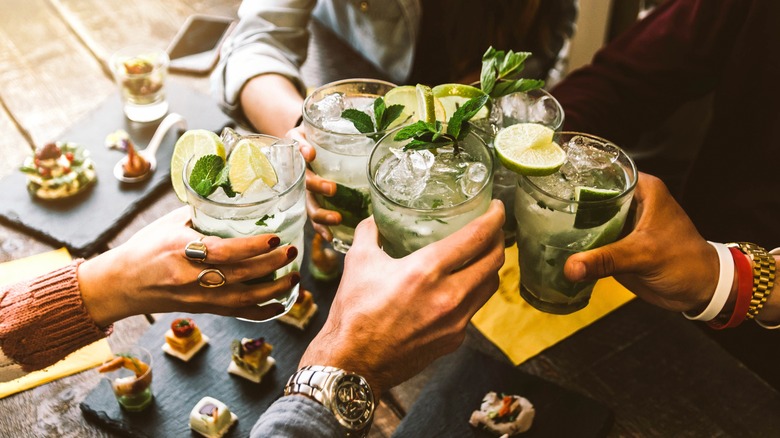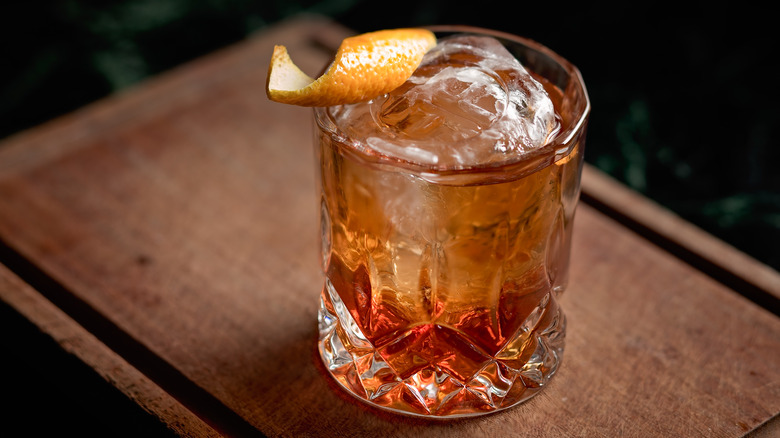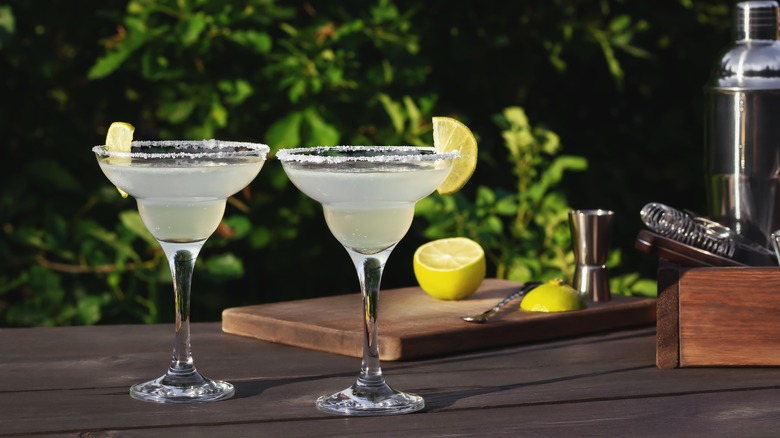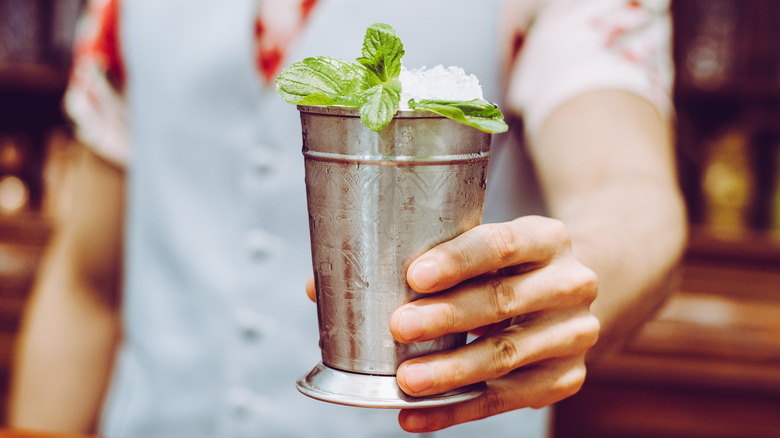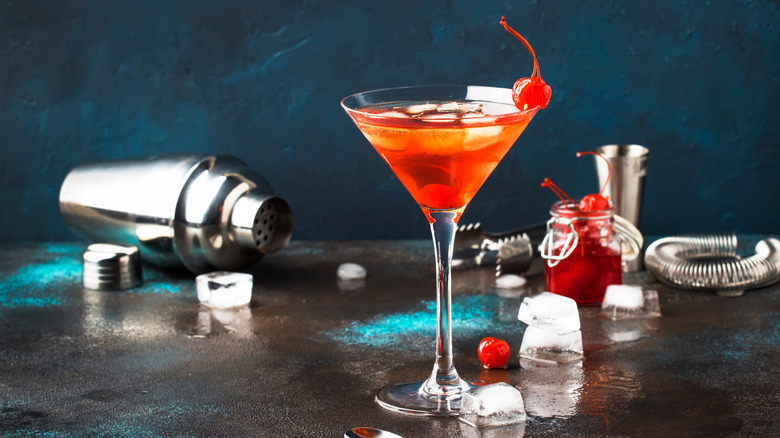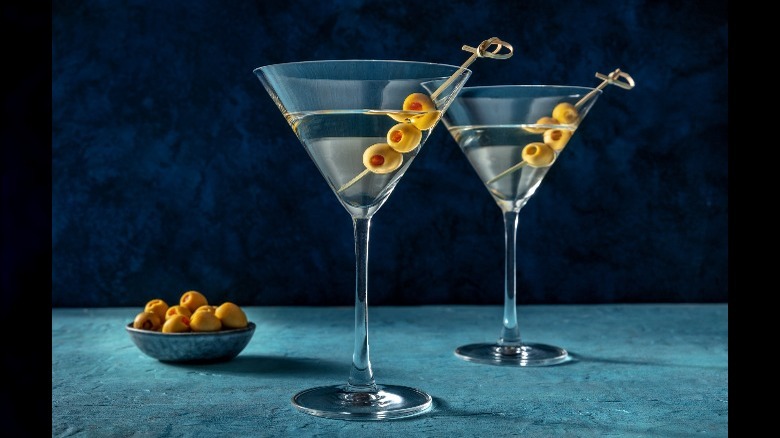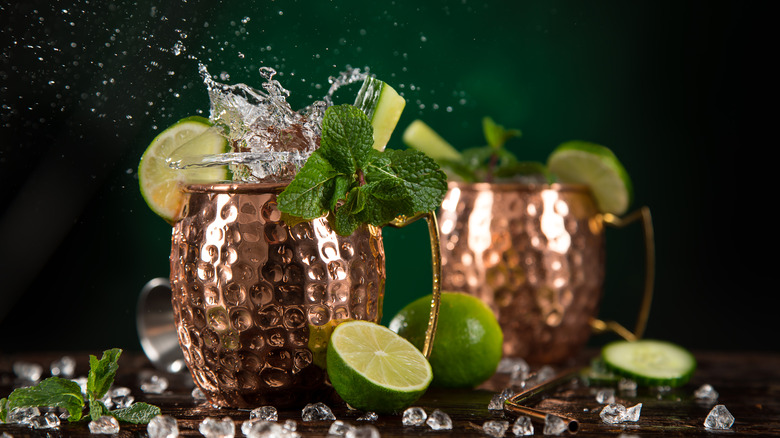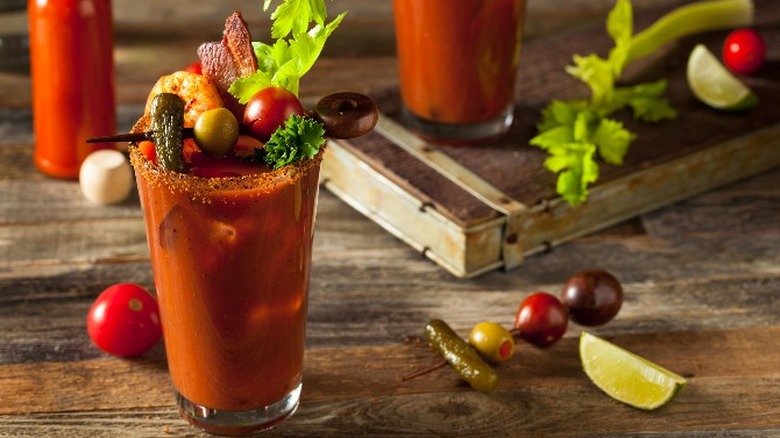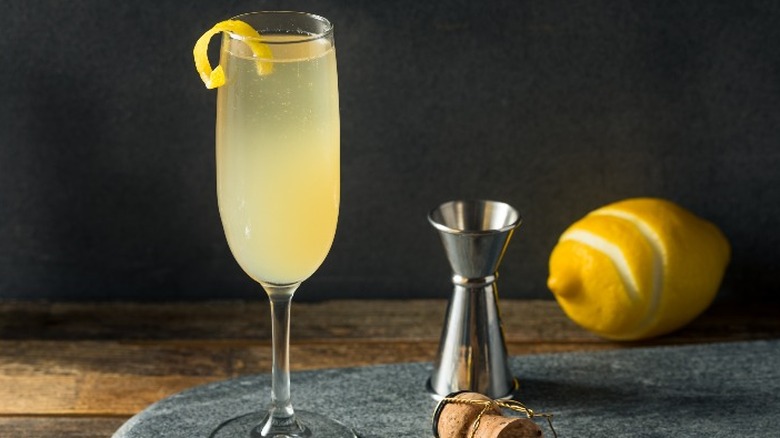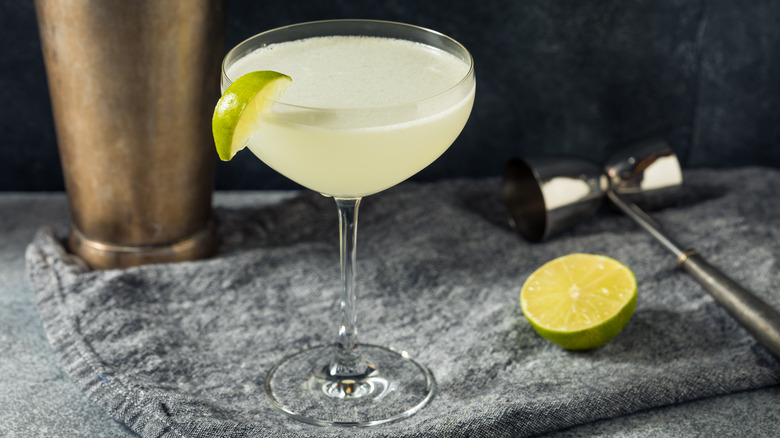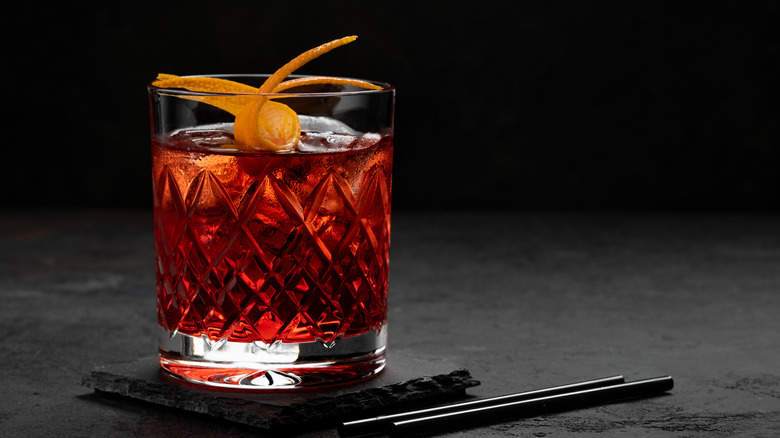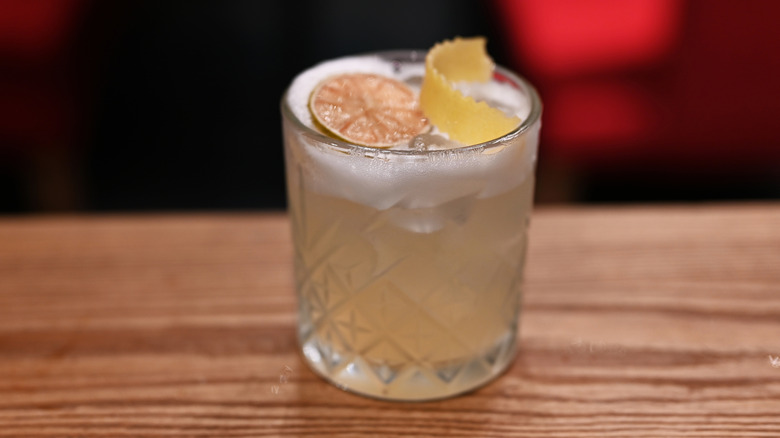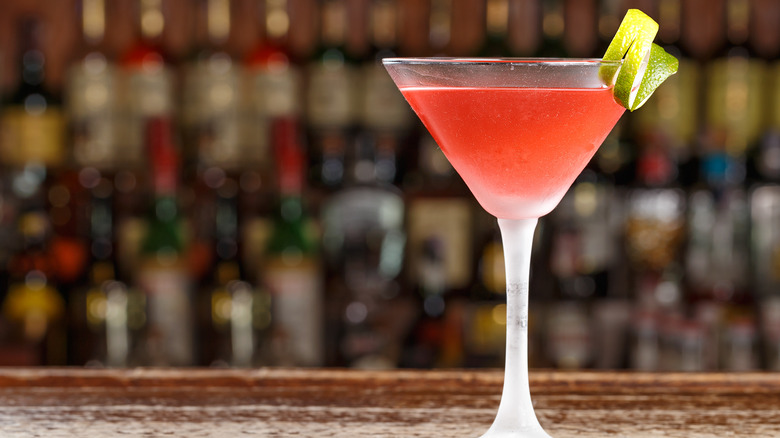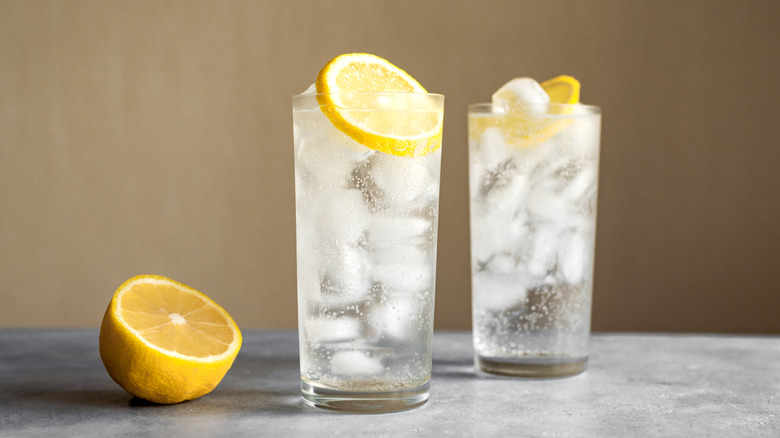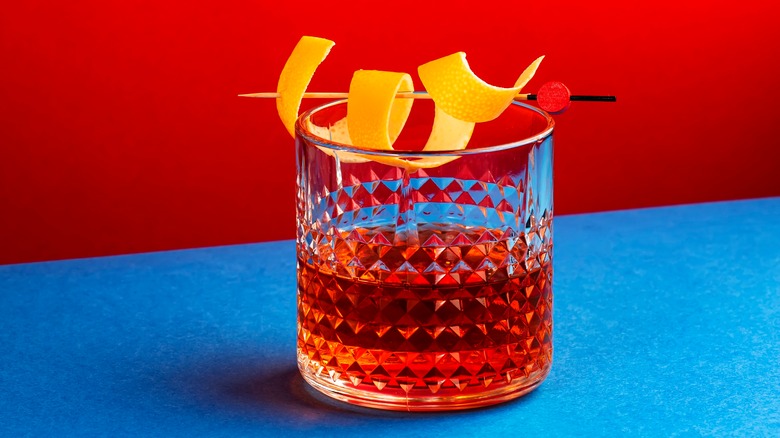14 Classic Cocktails Everyone Should Try Once In Their Life
Aside from beer and wine, cocktails are an assortment of alcoholic beverages that blend together a variety of flavors and textures, ranging from dry to sweet, smooth to bubbly, and simple to complex. In fact, there are so many different kinds of cocktails out there, that experts have had to come up with ways of sorting them into families to help categorize the different profiles based on ingredients, techniques, and even glassware. Becoming a cocktail connoisseur is by no means a requirement to enjoy them, but learning a thing or two about the history and components of these drinks can come in handy when hosting friends for dinner or figuring out what to order when you head out to the bar.
No matter what, there are several classic cocktails that everyone should try at least once, and it might not hurt to learn how to whip some of these up at your home bar. The good news is that there is a cocktail out there for just about every tastebud and preference, so read up on some of the following quintessential cocktails and try one or two next time you go out.
Old Fashioned
One of the most iconic classic cocktails is the Old Fashioned. While some combination of alcohol, sugar, and bitters has been around for hundreds of years, the history of the Old Fashioned specifically likely dates back to the 1860s, when its original recipe did not include whiskey, but rather gin (via Thrillist). Since then, it has evolved into the simple yet quintessential bar cocktail we know today. According to Difford's Guide, its recognizable orange peel did not make an appearance with the Old Fashioned until after the years of Prohibition in America. Nowadays, you will not find a proper Old Fashioned without the garnish added.
Making an Old Fashioned is relatively straightforward and any aspiring home mixologist should be able to master it in no time. In fact, any well-stocked home bar should already have the essential ingredients: sugar, water, bitters, and whiskey, only necessitating a trip to the grocery store to pick up your orange for the garnish. If you want to rise to the occasion and mix your drinks like the professionals, make sure you have large ice cubes stocked in your freezer. Take your beverage to the next level and impress all of your friends the next time they come over with a round of Old Fashioned cocktails (and make sure you have the correct glassware on hand).
Margarita
The Margarita is a tequila-based cocktail that can come in seemingly countless varieties and flavors, but the traditional version contains just a few key ingredients. While the recipe is straightforward, however, the drink's history and origins are more complicated than you'd think. While most associate Margaritas with Mexican cuisine, Carlos "Danny" Herrera from Tijuana is not the only person who has claimed to be the first to concoct the beverage (via Vine Pair). In fact, per Difford's Guide, the Margarita may have been originally invented in the 1930s by an Irishman by the name of Madden. No matter the origins, the Margarita has since risen to immense popularity, particularly in the United States.
Most bars will have all of the essential Margarita ingredients on hand for you to try, and if you want to make one at home, it is one of the easier drinks to master when starting out. All you need is tequila, triple sec, and lime juice. You can salt the rim of your margarita glass for an added touch, and garnish with a lime wedge. From there, you can customize your Margarita in a number of ways, including adding ingredients like jalapeños, cucumbers, or various fruit purees.
Mint Julep
Associated with the Kentucky Derby, the Mint Julep is a classic American cocktail that offers a refreshing burst of minty flavor on a hot spring or summer day. But do not make the assumption that Churchill Downs is the only place to enjoy this beverage.
According to Lux Row Distillers, the Mint Julep's history is deeply rooted in America, dating back to the Southern states in the 1700s. The drink itself is only as iconic as the pewter cup it is traditionally served in, marking it as a cocktail for the elite when it first hit the social scenes over 200 years ago. Over a century after it first appeared, the drink became officially associated with the Kentucky Derby in 1938. The association with the south continued in the 1930s, as the drink was mentioned several times in "Gone With the Wind," according to Town and Country Magazine.
Do not wait until the next Kentucky Derby to try a Mint Julep for yourself. Making this drink is deceptively simple: All you need is bourbon, simple syrup, and mint leaves to muddle (and an extra sprig as a garnish). Serve over a mountain of crushed ice in a highball glass, or if you have a traditional silver or pewter cup, even better.
Manhattan
While the exact details of how the Manhattan first came about are unknown, the consensus is that the cocktail made its debut around the 1880s, according to Spirit of York. According to ancient history, the drink was made at a gathering in New York City by Dr. Iain Marshall for Lady Randolph Churchill (yes, that Churchill — Lady Randolph would later give birth to Winston). Timelines did not seem to line up with Lady Randolph's pregnancy, however, so that story has since become more myth than fact (per Taste Cocktails).
Initially, a Manhattan recipe included French vermouth, whiskey, and Angostura bitters, but evolved and was modified over time to the recipe that we know and love today. Early recipes also included absinthe (via Taste Cocktails). There are also a variety of ways you can customize your Manhattan, such as subbing dry vermouth for sweet vermouth, making a Dry Manhattan (via Spirit of York). Typically, you would not serve a Manhattan over ice, because the water would dilute the ingredients.
Martini
If you have watched any James Bond film, the mere mention of a Martini may elicit a witty response of "shaken, not stirred." But the cocktail dates back much further than the earliest Ian Fleming novels, as far back as the 1860s depending on whether you consider the Martinez Cocktail to be the parent cocktail that eventually morphed into what we now know as a Martini (via Difford's Guide). The Martinez Cocktail is actually an offshoot of the Manhattan, only you would use gin instead of whiskey. Eventually, several iterations later, the Martini settled on the simple recipe bartenders everywhere know today: a mixture of gin and vermouth, garnished with its signature olive.
As its history suggests, there are countless ways you can customize a Martini, from adding various flavors and sweeteners to stripping it down to its essential two ingredients. The whole shaken versus stirred debate simply comes down to how you prefer your Martini (or any cocktail, for that matter) to hit your palette. According to Cocktail Crate, shaking a cocktail prior to pouring and serving provides a brighter consistency as well as a quick way to chill a drink, while stirring produces a smoother consistency. Give both methods a try as you work your way through these classic cocktails to see which one you prefer.
Moscow Mule
Some cocktails are recognizable based on the vessel that they are served in, and the Moscow Mule is no exception. You should instantly tell someone is drinking a Mule from its signature copper mug. Not so obvious, however, are the drink's origins: Despite the Moscow moniker, the cocktail actually first came about in Los Angeles in the 1940s. A surplus of ginger beer and Smirnoff vodka brought the two unlikely ingredients together, creating the first Moscow Mule.
The creators decided to market the new creation by engraving the names of its VIP clientele into each of the copper mugs it had on hand — sort of like modern-day mug clubs bars and breweries offer (via Artisan's Anvil). The appeal of the customized copper mugs, plus the fact that the copper kept the cocktails cooler for longer, was a match made in cocktail heaven, and you would be hard-pressed to find a Moscow Mule served in anything but a copper mug these days.
Making a Moscow Mule at home? Make sure you have copper mugs on deck, and then mix together lime juice, vodka, and ginger beer. Garnish with a lime wedge and some mint leaves and presto. You can also mix things up and make a Mexican Mule, which substitutes tequila for vodka.
Bloody Mary
If you have ever gone out to brunch with a group of friends or you find yourself on a morning flight, you have probably seen someone order a Bloody Mary. The peculiar yet popular tomato juice cocktail first came about in Paris at Harry's New York Bar in the 1920s, where a mixture of nationalities and cultures met, blending an unlikely duo of vodka and tomato juice (via Silver Circle Distillery). As the story goes, the bartender at Harry's, Fernand "Pete" Petiot, took it upon himself to add the spices and garnishes that make a Bloody Mary what it is today.
Today, you can find Bloody Mary cocktails of all shapes and sizes. Most of the time, the drink will come with Worcestershire sauce, tabasco, black pepper, and a stalk of celery. But your imagination can really run wild with this drink, and the garnishes can become quite extravagant, as some of the best Bloody Marys in the U.S. do. Do not be surprised if your local brunch spot whips out anything from peppers to fried shrimp to slices of pizza as a garnish for the Bloody Mary.
French 75
Champagne-based cocktails are a popular choice for those who prefer their drinks to be on the bubbly side, and they do not get any more classic than the French 75. It is one of those drinks held in high regard by mixologists and cocktail connoisseurs, and it is certainly one you should have at least once if you want to try all of the classic drinks. The name came about during World War I, when the French army had an affinity for the 75-millimeter light field gun as their preferred weapon. The weapon inspired a champagne-based cocktail in France simply called the Seventy-Five (or Soixante-Quinze in its native tongue).
Like many of the other cocktails included in this list, the French 75 has changed somewhat over time. Back in its earliest days, there were no traces of champagne to be found at all in its recipe, with the only consistent component being gin (via Difford's Guide). It was not until the 1920s that the 75 became more widely known as the French 75, and champagne was added to the mix. That version of the recipe has stuck around ever since, with the current recipe including dry gin, champagne, lemon juice, and powdered sugar (via Difford's Guide).
Because of the champagne component, you will often see French 75 cocktails served in champagne flutes, but it is also not uncommon to see them served in highball-style Collins glasses (via Difford's Guide).
Daiquiri
Some of you may have been first introduced to a virgin Daiquiri before reaching the legal drinking age, which at many bars resembles a fruit smoothie more than a cocktail. Indeed, the Strawberry Daiquiri is perhaps one of the most popular versions of this drink, but its classic recipe contains no traces of fruit whatsoever. The Daiquiri dates back to the turn of the 20th century, when it was believed the drink was first invented in the Cuban village of Daiquirí. Early versions of the cocktail's recipe called for three simple ingredients: lime juice, rum, and powdered sugar for added sweetness (via Difford's Guide). Ernest Hemingway helped popularize the cocktail in the United States during the 20th century, and Daiquiris are a standard fixture of bar menus nationwide.
When ordering a classic Daiquiri, you will likely be served a mixture of rum, lime juice, and simple syrup. But the recipes can get more complex than that, and there are usually several versions available at bars with fruit flavors mixed in, especially strawberry. If you are looking to make a strawberry Daiquiri at home, you might want to consider which strawberry mixes are best (and worst).
Negroni
The Negroni had a bit of a viral moment in 2022 thanks to "House of the Dragon" star Emma D'Arcy and an interview snippet that spread like wildfire on TikTok, but this classic cocktail has been a bar staple for what feels like as long as the Targaryens have been in power. Its exact origins are up for debate, with many possible claims as to where it came from (via Difford's Guide). One thing is certain, though: It is a rather simple cocktail to make that everyone should try at least once.
Its basic recipe includes Campari, gin, and sweet vermouth, but you can customize it in a number of ways that suit you best. Difford's Guide offers countless variations of the Negroni, but if you want to try Emma D'Arcy's preferred Negroni Sbagliato (which means "mistaken Negroni" in Italian), swap in sparkling wine for gin — and make it Prosecco if you want to really to commit to D'Arcy's drink of choice.
Whiskey Sour
The Whiskey Sour was likely invented at sea. According to Alcohol Professor, long voyages often necessitated alcoholic drinks, as they were one of the few things to consume that would not go rotten. It was also believed that lemons and limes were helpful in preventing illnesses like scurvy, so over time the citrus and whiskey on board were combined to create what we know today as the Whiskey Sour.
For a drink that was likely created out of necessity for sailors, the Whiskey Sour is now considered a quintessential beverage for mixologists and cocktail connoisseurs. Some recipes call for egg whites (via Alcohol Professor), though this is an optional ingredient depending on how much you want to fancy up your cocktail. According to Alcohol Professor, some bartenders may consider that the addition of egg whites makes it a different drink entirely. Adding honey to the cocktail would also make it what is known as a Gold Rush. No matter how you mix your Whiskey Sour, it is usually suggested that you add a cherry as a garnish.
Cosmopolitan
The coloring of a Cosmopolitan makes it instantly recognizable, with its signature pink hues coming from the blend of cranberry juice and vodka. In fact, the classic cocktail is quite similar to the standard vodka cranberry drink many would normally order at a bar, but with the key addition of lime juice. So, next time you are at a bar, do not settle for just two-thirds of the ingredients — after all, doesn't ordering a Cosmopolitan sound way fancier than just ordering a vodka cran?
If you have ever wanted to channel your inner Carrie Bradshaw, head to the bar and order a Cosmo. Or, stock up on those three simple ingredients and mix one at home yourself. Either way, you will have an easy go-to drink of choice next time you want to impress your friends with your cocktail knowledge.
Tom Collins
The Tom Collins has prankster origins that date back to 1876 when it first appeared in "The Bartender's Guide" by Jerry Thomas (via Spirits Beacon). A variation of a highball, the Tom Collins takes the base cocktail of a highball and substitutes gin for rye and adds sugar and the citrus of lemon juice (via Quarentinis, Eh?), essentially making it a fancy, fizzy, spiked lemonade of sorts. Traditionally, these cocktails are served in classic highball-style glasses. There are several versions of the Tom Collins, including the John Collins, which swaps out the gin for bourbon. The Tom Collins also bares a striking resemblance to the Gin Fizz, with near-identical ingredients, but with one key distinction: The Gin Fizz is shaken and served without ice, while the Tom Collins is poured over ice sans shaking.
If you want, you can ask the bartender if they can throw in lime juice for an added dose of citrus flavor, or you can order it as is and you will still get the benefit of the lemon juice included.
Sazerac
As the official drink of the city of New Orleans (and a signature fixture of the state of Louisiana for over 100 years, per Liquor.com), the Sazerac has deep American roots that go back to the early 1800s. Named after a French brandy of the same name, the Sazerac was reportedly invented right on Royal Street, and since then has taken on different ingredients, much like the other cocktails included on this list. The drink was officially crowned as the official New Orleans cocktail in 2008, according to NewOrleans.com.
Fear not, because you do not have to be in New Orleans to order a Sazerac. Much like a Mint Julep at the Kentucky Derby, the drink is associated with a particular location, but bars nationwide should have the ingredients on hand. With whiskey or bourbon as its base, you mix in bitters and either absinthe or herbsaint. Stir and enjoy.
